Abstract: in fact, in the design of a CPU, each sub module is relatively basic and simple, but the combined overall architecture will be more complex, whether it is timing path, data path and control path. Here, we mainly introduce the sub modules of the whole microarchitecture in detail.
1. PC fetch, PC branch, instruction jump and L2 stack
PC fetch means that the PC value is mainly used as the address to read the instruction data in the program memory (EPROM) and send it to the instruction register IR. Usually, it is read out one by one, that is, the PC value is automatically increased by one in the next clock (pipelined clock) to read the instruction where the next address is located (of course, the modification of PC depends on the instruction word length and addressing mode). However, sometimes there are program branches, program jumps and so on, so that the program needs to execute the instructions of another region, so there is a PC branch.
1.1 PC branches are generally divided into the following situations:
- RETLW: return to assign stack stack1 or stack2 to PC;
- CALL: CALL, assign status[6:5],1'b0,inst[7:0] to PC;
- GOTO: jump, assign status[6:5],inst[8:0] to PC;
- MOVWF: MOVWF PCL, assign pc[10:8],dbus to PC; (in addition, there are ADDWF and BSF, which are not implemented here);
- DEFAULT: PC <- PC + 1.
1.2 for instruction Jump, the instructions that can make the instruction Jump include GOTO, CALL, RETLW, BTFSC, BTFSS, DECFSZ and INCFSZ.
1.3. For the call and return of stacklevel, the state machine is used, as follows. The number in the circle represents stack level, and the number on the right represents the number of subroutine layers that have been called.
-
When the CALL instruction is executed, the stack pressing operation is push ed, the PC assigns a value to the stack, and changes the state of stacklevel at the same time;
-
When RETLW instruction is executed, pop-up operation pop is performed, the stack is returned to PC, and the state of stacklevel is changed at the same time.
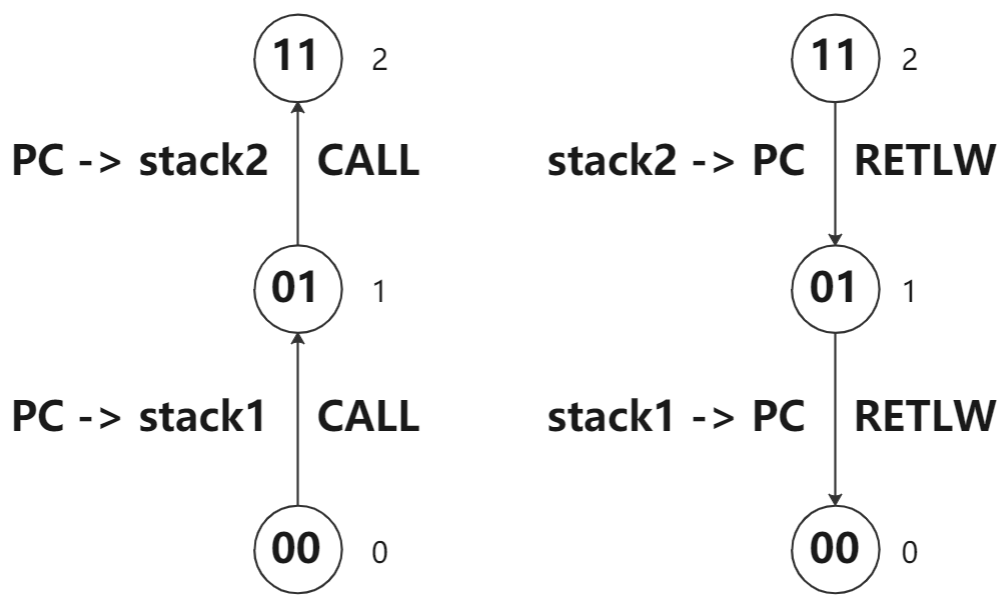
The detailed circuit module and Verilog code are as follows:
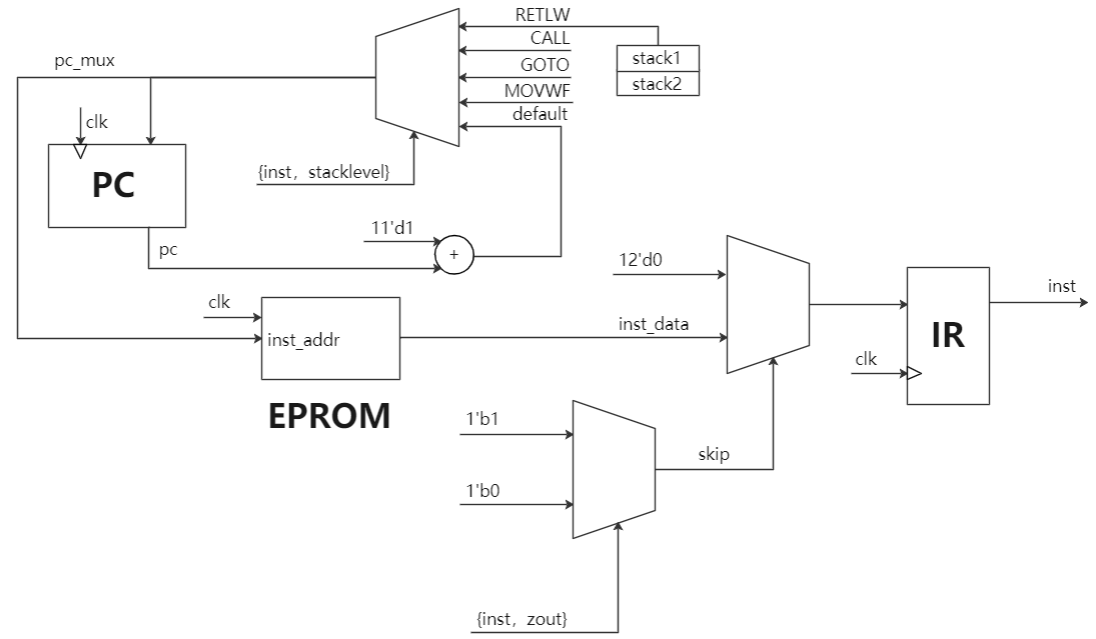
always @(posedge clk) begin
if (!rst_n)
pc <= RESET_VECTOR;
else
pc <= pc_mux;
end
always @(inst or stacklevel or status or stack1 or stack2 or pc or dbus) begin
casex ({inst, stacklevel})
14'b1000_????_????_11: pc_mux = stack2; // RETLW
14'b1000_????_????_01: pc_mux = stack1; // RETLW
14'b1001_????_????_??: pc_mux = {status[6:5], 1'b0, inst[7:0]}; // CALL
14'b101?_????_????_??: pc_mux = {status[6:5], inst[8:0]}; // GOTO
14'b00?0_0010_0010_??: pc_mux = {pc[10:8], dbus}; // MOVWF PCL
default:
pc_mux = pc + 11'd1;
endcase
end
always @(posedge clk) begin
if (!rst_n) begin
stack1 <= 11'd0;
stack2 <= 11'd0;
end
else begin
// CALL Instruction
if (inst[11:8] == 4'b1001) begin
case (stacklevel)
2'b00: stack1 <= pc;
2'b01: stack2 <= pc;
default: begin
stack1 <= 11'd0;
stack2 <= 11'd0;
end
endcase
end
end
end
always @(posedge clk) begin
if (!rst_n)
stacklevel <= 2'b00;
else begin
casex ({inst, stacklevel})
// CALL Instruction
14'b1001_????_????_00: stacklevel <= 2'b01; // Record 1st CALL
14'b1001_????_????_01: stacklevel <= 2'b11; // Record 2nd CALL
14'b1001_????_????_11: stacklevel <= 2'b11; // Ignore
// RETLW Instruction
14'b1000_????_????_11: stacklevel <= 2'b01; // Go back to 1 CALL in progress
14'b1000_????_????_01: stacklevel <= 2'b00; // Go back to no CALL in progress
14'b1000_????_????_00: stacklevel <= 2'b00; // Ignore
default:
stacklevel <= stacklevel;
endcase
end
end
always @(posedge clk) begin
if(!rst_n)
inst <= 12'h000;
else begin
if(skip == 1'b1)
inst <= 12'b000000000000; // FORCE NOP
else
inst <= inst_data;
end
end
always @(inst or aluz) begin
casex ({inst, aluz})
13'b10??_????_????_?: skip = 1'b1; // A GOTO, CALL or RETLW instructions
13'b0110_????_????_1: skip = 1'b1; // BTFSC instruction and aluz == 1
13'b0111_????_????_0: skip = 1'b1; // BTFSS instruction and aluz == 0
13'b0010_11??_????_1: skip = 1'b1; // DECFSZ instruction and aluz == 1
13'b0011_11??_????_1: skip = 1'b1; // INCFSZ instruction and aluz == 1
default: skip = 1'b0;
endcase
end2. Instruction decoding
The instruction decoding is mainly realized through the combinational logic hardware circuit (in the form of Look Up Table), and the key control and status signals are provided for the instruction. For the specific decoding method, refer to the following code.
aluasel, alubsel: it is mainly used to select the operands of ALU module. The operands generally come from W register, F file register and instruction immediate;
aluop: it is mainly used to select the operation of ALU module, such as addition, subtraction, and, or, non, XOR, shift left, shift right and half byte exchange;
wwe, fwe: mainly write enable of W and F registers;
zwe, cwe: mainly write enable the Z and C STATUS bits of the STATUS register;
bdpol: related to bit oriented operation instructions;
tris: control I/O input and output status (none);
OPTION: OPTION register (none).
The detailed circuit module and Verilog code are as follows:
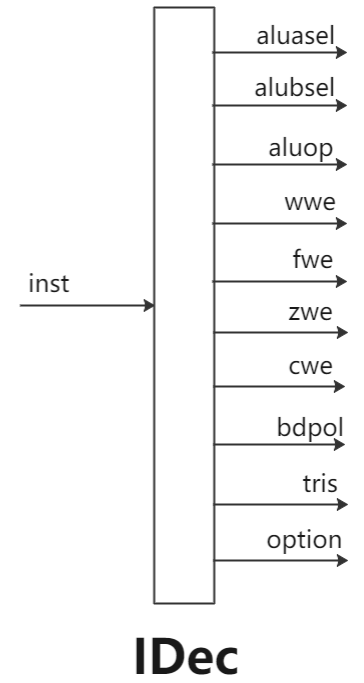
module IDec (
inst,
aluasel,
alubsel,
aluop,
wwe,
fwe,
zwe,
cwe,
bdpol,
option,
tris
);
input [11:0] inst;
output [1:0] aluasel;
output [1:0] alubsel;
output [3:0] aluop;
output wwe;
output fwe;
output zwe;
output cwe;
output bdpol;
output option;
output tris;
reg [14:0] decodes;
assign {aluasel, // Select source for ALU A input. 00=W, 01=SBUS, 10=K, 11=BD
alubsel, // Select source for ALU B input. 00=W, 01=SBUS, 10=K, 11="1"
aluop, // ALU Operation (see comments above for these codes)
wwe, // W register Write Enable
fwe, // File Register Write Enable
zwe, // Status register Z bit update
cwe, // Status register Z bit update
bdpol, // Polarity on bit decode vector (0=no inversion, 1=invert)
tris, // Instruction is an TRIS instruction
option // Instruction is an OPTION instruction
} = decodes;
always @(inst) begin
casex (inst)
// *** Byte-Oriented File Register Operations
//
// A A ALU W F Z C B T O
// L L O W W W W D R P
// U U P E E E E P I T
// A B O S
// L
12'b0000_0000_0000: decodes = 15'b00_00_0000_0_0_0_0_0_0_0; // NOP
12'b0000_001X_XXXX: decodes = 15'b00_00_0010_0_1_0_0_0_0_0; // MOVWF
12'b0000_0100_0000: decodes = 15'b00_00_0011_1_0_1_0_0_0_0; // CLRW
12'b0000_011X_XXXX: decodes = 15'b00_00_0011_0_1_1_0_0_0_0; // CLRF
12'b0000_100X_XXXX: decodes = 15'b01_00_1000_1_0_1_1_0_0_0; // SUBWF (d=0)
12'b0000_101X_XXXX: decodes = 15'b01_00_1000_0_1_1_1_0_0_0; // SUBWF (d=1)
12'b0000_110X_XXXX: decodes = 15'b01_11_1000_1_0_1_0_0_0_0; // DECF (d=0)
12'b0000_111X_XXXX: decodes = 15'b01_11_1000_0_1_1_0_0_0_0; // DECF (d=1)
12'b0001_000X_XXXX: decodes = 15'b00_01_0010_1_0_1_0_0_0_0; // IORWF (d=0)
12'b0001_001X_XXXX: decodes = 15'b00_01_0010_0_1_1_0_0_0_0; // IORWF (d=1)
12'b0001_010X_XXXX: decodes = 15'b00_01_0001_1_0_1_0_0_0_0; // ANDWF (d=0)
12'b0001_011X_XXXX: decodes = 15'b00_01_0001_0_1_1_0_0_0_0; // ANDWF (d=1)
12'b0001_100X_XXXX: decodes = 15'b00_01_0011_1_0_1_0_0_0_0; // XORWF (d=0)
12'b0001_101X_XXXX: decodes = 15'b00_01_0011_0_1_1_0_0_0_0; // XORWF (d=1)
12'b0001_110X_XXXX: decodes = 15'b00_01_0000_1_0_1_1_0_0_0; // ADDWF (d=0)
12'b0001_111X_XXXX: decodes = 15'b00_01_0000_0_1_1_1_0_0_0; // ADDWF (d=1)
12'b0010_000X_XXXX: decodes = 15'b01_01_0010_1_0_1_0_0_0_0; // MOVF (d=0)
12'b0010_001X_XXXX: decodes = 15'b01_01_0010_0_1_1_0_0_0_0; // MOVF (d=1)
12'b0010_010X_XXXX: decodes = 15'b01_01_0100_1_0_1_0_0_0_0; // COMF (d=0)
12'b0010_011X_XXXX: decodes = 15'b01_01_0100_0_1_1_0_0_0_0; // COMF (d=1)
12'b0010_100X_XXXX: decodes = 15'b01_11_0000_1_0_1_0_0_0_0; // INCF (d=0)
12'b0010_101X_XXXX: decodes = 15'b01_11_0000_0_1_1_0_0_0_0; // INCF (d=1)
12'b0010_110X_XXXX: decodes = 15'b01_11_1000_1_0_0_0_0_0_0; // DECFSZ(d=0)
12'b0010_111X_XXXX: decodes = 15'b01_11_1000_0_1_0_0_0_0_0; // DECFSZ(d=1)
12'b0011_000X_XXXX: decodes = 15'b01_01_0101_1_0_0_1_0_0_0; // RRF (d=0)
12'b0011_001X_XXXX: decodes = 15'b01_01_0101_0_1_0_1_0_0_0; // RRF (d=1)
12'b0011_010X_XXXX: decodes = 15'b01_01_0110_1_0_0_1_0_0_0; // RLF (d=0)
12'b0011_011X_XXXX: decodes = 15'b01_01_0110_0_1_0_1_0_0_0; // RLF (d=1)
12'b0011_100X_XXXX: decodes = 15'b01_01_0111_1_0_0_0_0_0_0; // SWAPF (d=0)
12'b0011_101X_XXXX: decodes = 15'b01_01_0111_0_1_0_0_0_0_0; // SWAPF (d=1)
12'b0011_110X_XXXX: decodes = 15'b01_11_0000_1_0_0_0_0_0_0; // INCFSZ(d=0)
12'b0011_111X_XXXX: decodes = 15'b01_11_0000_0_1_0_0_0_0_0; // INCFSZ(d=1)
// *** Bit-Oriented File Register Operations
12'b0100_XXXX_XXXX: decodes = 15'b11_01_0001_0_1_0_0_1_0_0; // BCF
12'b0101_XXXX_XXXX: decodes = 15'b11_01_0010_0_1_0_0_0_0_0; // BSF
12'b0110_XXXX_XXXX: decodes = 15'b11_01_0001_0_0_0_0_0_0_0; // BTFSC
12'b0111_XXXX_XXXX: decodes = 15'b11_01_0001_0_0_0_0_0_0_0; // BTFSS
// *** Literal and Control Operations
12'b0000_0000_0010: decodes = 15'b00_00_0010_0_1_0_0_0_0_1; // OPTION
12'b0000_0000_0011: decodes = 15'b00_00_0000_0_0_0_0_0_0_0; // SLEEP
12'b0000_0000_0100: decodes = 15'b00_00_0000_0_0_0_0_0_0_0; // CLRWDT
12'b0000_0000_0101: decodes = 15'b00_00_0010_0_1_0_0_0_1_0; // TRIS 5
12'b0000_0000_0110: decodes = 15'b00_00_0010_0_1_0_0_0_1_0; // TRIS 6
12'b0000_0000_0111: decodes = 15'b00_00_0010_0_1_0_0_0_1_0; // TRIS 7
12'b1000_XXXX_XXXX: decodes = 15'b10_10_0010_1_0_0_0_0_0_0; // RETLW
12'b1001_XXXX_XXXX: decodes = 15'b10_10_0010_0_0_0_0_0_0_0; // CALL
12'b101X_XXXX_XXXX: decodes = 15'b10_10_0010_0_0_0_0_0_0_0; // GOTO
12'b1100_XXXX_XXXX: decodes = 15'b10_10_0010_1_0_0_0_0_0_0; // MOVLW
12'b1101_XXXX_XXXX: decodes = 15'b00_10_0010_1_0_1_0_0_0_0; // IORLW
12'b1110_XXXX_XXXX: decodes = 15'b00_10_0001_1_0_1_0_0_0_0; // ANDLW
12'b1111_XXXX_XXXX: decodes = 15'b00_10_0011_1_0_1_0_0_0_0; // XORLW
default: decodes = 15'b00_00_0000_0_0_0_0_0_0_0;
endcase
end
endmodule3. Instruction execution
The ALU module can basically perform all instruction operations. It may not be optimal, but it is complete.
alua, alub: operands, which perform the data operation of the corresponding instruction by selecting operands, such as W register, F register sbus, constant K, bit operand bd, and constant 1;
aluop: operation code, including nine arithmetic and logic operations: addition, subtraction, and, or, non, XOR, left shift, right shift and half byte exchange;
cin: as the low order of RRF for shift right operation;
Aluout: the operation result is output to the data bus as the output of ALU module, and finally select whether to save it in W register or F register; For example, aluout - > W or aluout - > DBUS -> regfilein --> regfileout ...> sbus;
zout, cout: flag bit, the change of status bit that may be caused by ALU operation.
The detailed circuit module and Verilog code are as follows:
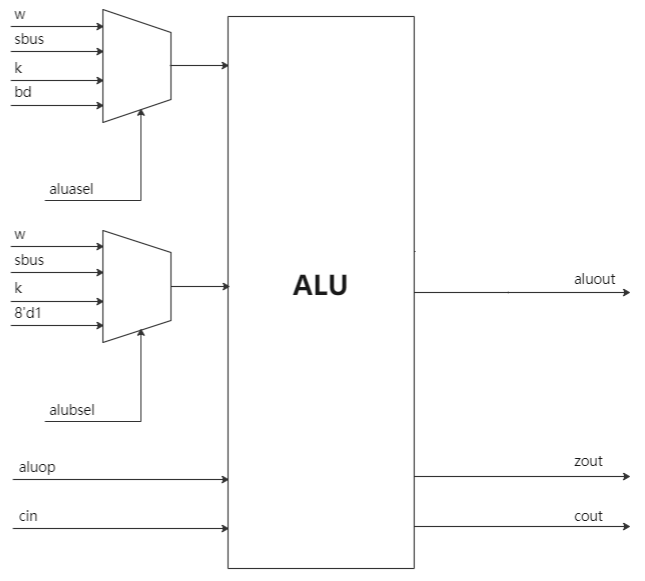
module ALU(
alua,
alub,
aluop,
cin,
aluout,
zout,
cout
);
input [7:0] alua;
input [7:0] alub;
input [3:0] aluop;
input cin;
output reg [7:0] aluout;
output reg zout;
output reg cout;
reg addercout;
parameter ALUOP_ADD = 4'b0000;
parameter ALUOP_SUB = 4'b1000;
parameter ALUOP_AND = 4'b0001;
parameter ALUOP_OR = 4'b0010;
parameter ALUOP_XOR = 4'b0011;
parameter ALUOP_COM = 4'b0100;
parameter ALUOP_ROR = 4'b0101;
parameter ALUOP_ROL = 4'b0110;
parameter ALUOP_SWAP = 4'b0111;
always @(alua or alub or cin or aluop) begin
case (aluop)
ALUOP_ADD: {addercout, aluout} = alua + alub;
ALUOP_SUB: {addercout, aluout} = alua - alub;
ALUOP_AND: {addercout, aluout} = {1'b0, alua & alub};
ALUOP_OR: {addercout, aluout} = {1'b0, alua | alub};
ALUOP_XOR: {addercout, aluout} = {1'b0, alua ^ alub};
ALUOP_COM: {addercout, aluout} = {1'b0, ~alua};
ALUOP_ROR: {addercout, aluout} = {alua[0], cin, alua[7:1]};
ALUOP_ROL: {addercout, aluout} = {alua[7], alua[6:0], cin};
ALUOP_SWAP: {addercout, aluout} = {1'b0, alua[3:0], alua[7:4]};
default: {addercout, aluout} = {1'b0, 8'h00};
endcase
end
always @(aluout)
zout = (aluout == 8'h00);
always @(addercout or aluop)
if(aluop == ALUOP_SUB)
cout = ~addercout;
else
cout = addercout;
endmodule
always @(aluasel or w or sbus or k or bd) begin
case (aluasel)
2'b00: alua = w;
2'b01: alua = sbus;
2'b10: alua = k;
2'b11: alua = bd;
endcase
end
always @(alubsel or w or sbus or k) begin
case (alubsel)
2'b00: alub = w;
2'b01: alub = sbus;
2'b10: alub = k;
2'b11: alub = 8'b00000001;
endcase
end4. Direct deposit access, indirect deposit access and relative deposit access
Direct memory access is the address of a register or memory in an instruction;
Indirect memory access is to access the register, and then there is the address of the register or memory in the register; For example, INDF Register is a global register with mappings in all banks, regardless of the setting of the Bank. It does not represent the address itself, but the unit to which the indirect address points;
Relative memory access refers to page memory access, which improves the storage capacity by expanding the page, and realizes memory access by selecting the page address (in PA1 and PA0 of STATUS) as the high bit of PC value.
Through the determination of the instruction address, the corresponding control signal is output, and the corresponding register is selected for reading and writing.
The detailed circuit module and Verilog code are as follows:
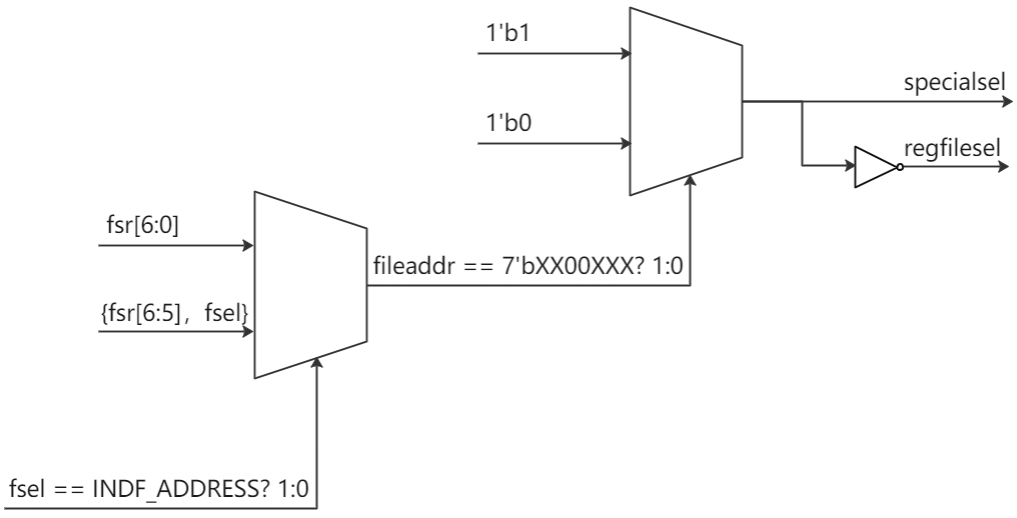
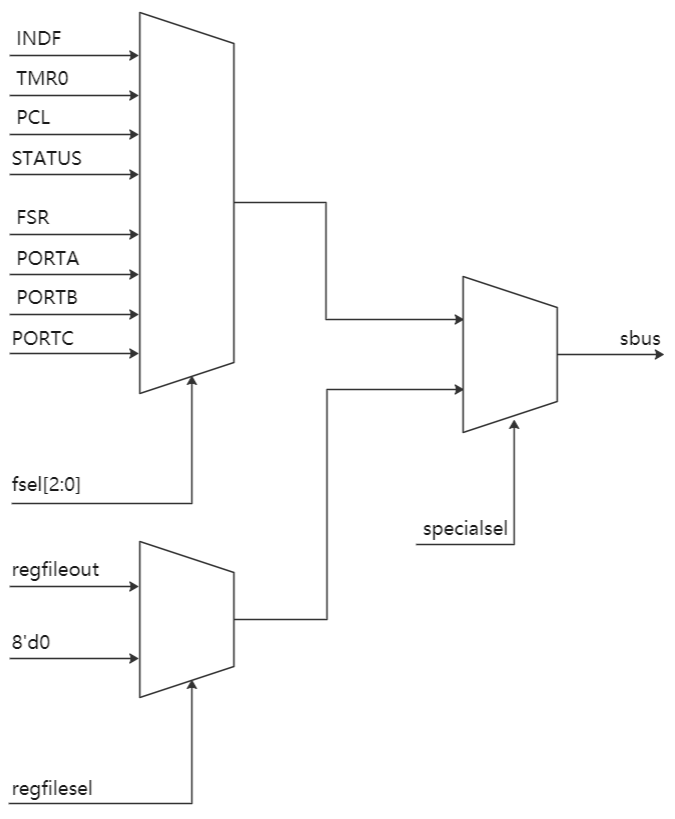
always @(fsel or fsr) begin
if (fsel == INDF_ADDRESS)
fileaddr = fsr[6:0]; // Indirect
else
fileaddr = {fsr[6:5], fsel}; // Direct
end
always @(fileaddr) begin
casex (fileaddr)
7'bXX00XXX: begin
specialsel = 1'b1;
regfilesel = 1'b0;
end
default: begin
specialsel = 1'b0;
regfilesel = 1'b1;
end
endcase
end
always @(*) begin
if(specialsel) begin
case (fsel[2:0])
3'h0: sbus = fsr;
3'h1: sbus = tmr0;
3'h2: sbus = pc[7:0];
3'h3: sbus = status;
3'h4: sbus = fsr;
3'h5: sbus = porta; // PORTA is an input-only port
3'h6: sbus = portb; // PORTB is an output-only port
3'h7: sbus = portc; // PORTC is an output-only port
endcase
end
else begin
if(regfilesel)
sbus = regfileout;
else
sbus = 8'h00;
end
end5. F register and W register
F register is divided into special register and general register. Special register is stored as a separate register. Like W register, general register exists in the form of RAM. Their read-write delay requires a clock for writing data and no clock for reading data.
The key circuit modules and Verilog codes are as follows:
`define DEBUG_SHOWREADS
`define DEBUG_SHOWWRITES
module regs(clk, rst_n, we, re, bank, location, din, dout);
input clk;
input rst_n;
input we;
input re;
input [1:0] bank;
input [4:0] location;
input [7:0] din;
output [7:0] dout;
reg [6:0] final_address;
dram dram (
.clk (clk),
.address (final_address),
.we (we),
.din (din),
.dout (dout)
);
always @(bank or location) begin
casex ({bank, location})
7'b00_01XXX: final_address = {4'b0000, location[2:0]};
7'b01_01XXX: final_address = {4'b0000, location[2:0]};
7'b10_01XXX: final_address = {4'b0000, location[2:0]};
7'b11_01XXX: final_address = {4'b0000, location[2:0]};
// Bank #0
7'b00_10XXX: final_address = {4'b0001, location[2:0]};
7'b00_11XXX: final_address = {4'b0010, location[2:0]};
// Bank #1
7'b01_10XXX: final_address = {4'b0011, location[2:0]};
7'b01_11XXX: final_address = {4'b0100, location[2:0]};
// Bank #2
7'b10_10XXX: final_address = {4'b0101, location[2:0]};
7'b10_11XXX: final_address = {4'b0110, location[2:0]};
// Bank #3
7'b11_10XXX: final_address = {4'b0111, location[2:0]};
7'b11_11XXX: final_address = {4'b1000, location[2:0]};
default: final_address = {4'b0000, location[2:0]};
endcase
end
endmodule
module dram (
clk,
address,
we,
din,
dout
);
input clk;
input [6:0] address;
input we;
input [7:0] din;
output [7:0] dout;
parameter word_depth = 72;
reg [7:0] mem [0:word_depth-1];
assign dout = mem[address];
always @(posedge clk)
if (we)
mem[address] <= din;
endmoduleRecently, I'm busy and in a hurry. These are almost the key modules. Of course, they are storage mapping, writing of special registers, TMR0 pre frequency division, writing of test programs, etc. I haven't given the details of the whole project Download link.
I hope you can improve your FPGA design level by learning the relatively simple RISC CPU design, so the purpose of this paper has been achieved~